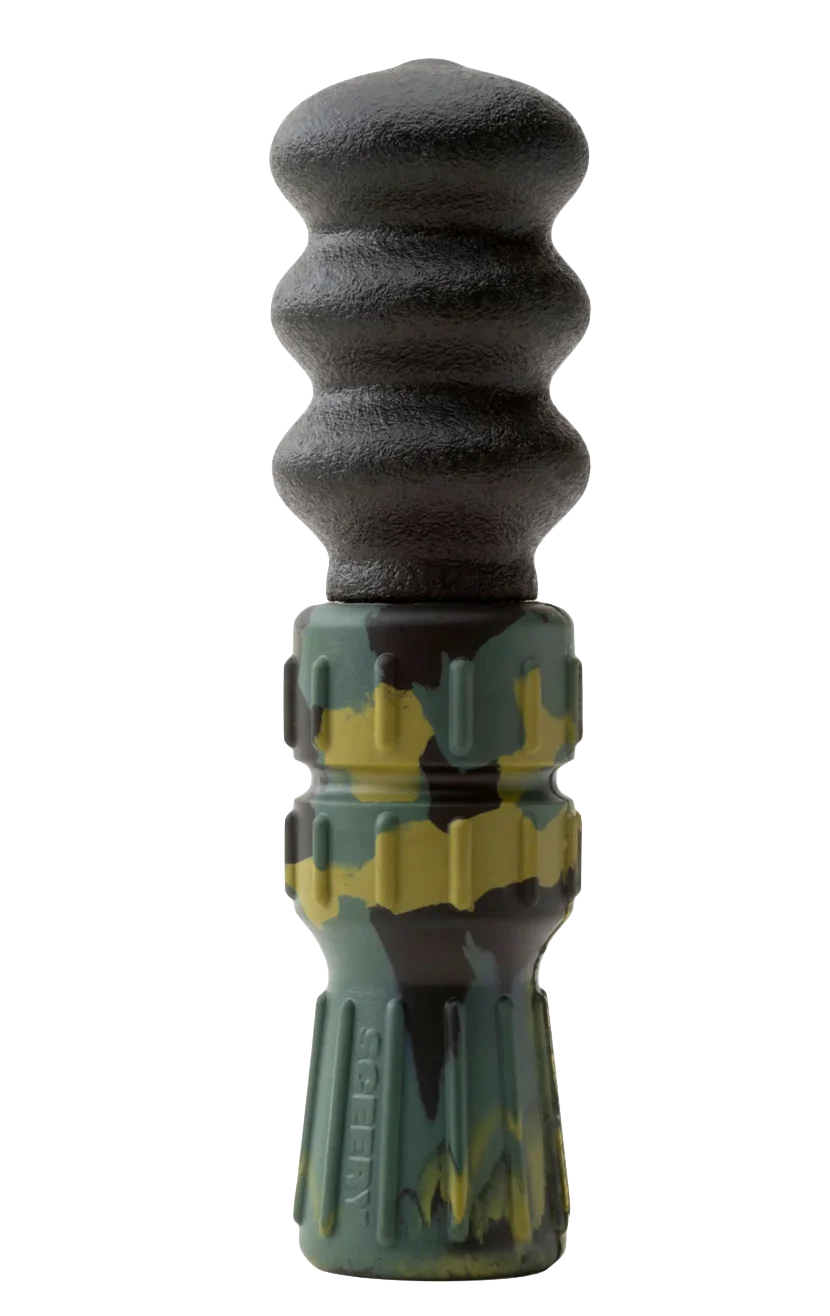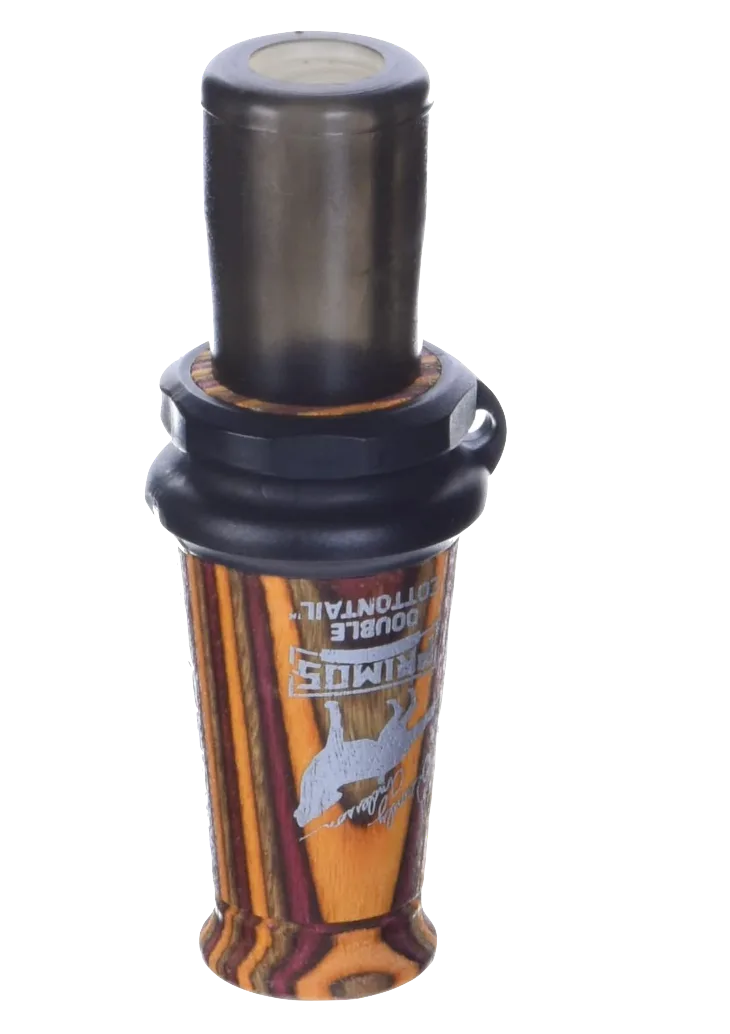We may earn revenue from the products available on this page and participate in affiliate programs. Learn more ›
To say that coyote hunting—and, subsequently, the market for coyote calls—has grown tremendously in popularity over the past two decades would be an understatement. From California to the Carolinas and everywhere in between, predator hunters are chasing ’yotes with an enthusiasm never before seen, and with good reason. Coyote hunting—successful coyote hunting—has few equals in terms of the challenge it presents. These wily canines can be incredibly difficult to outwit, seeing as practically everything on the planet, both man and beast, is out to get them in some way. Their sense of smell is unrivaled. Eyesight and hearing? Out of this world. Finally, fool one, and you still have to make the shot. This ain’t no walk in the park, Mister!
But fool them we do, on occasion, and in large part thanks to the almost infinite variety of thermal scopes and predator calls available. Many of the latter mimic a prey species, such as a cottontail rabbit, whitetail fawn, or even a field mouse. In layman’s terms, these calls reproduce the sound of an easy meal and can, if the stars align, bring a ’yote on the run. Others imitate coyotes themselves, howls meant to challenge or suggest there might be a receptive girl coyote hanging ’round. To help, we put together a list of some of the best coyote calls.
Best Overall: Ed Sceery’s Regional Predator Kits
Best Electronic Caller: MOJO Triple Threat E-Caller
Best Budget E-Caller: Primos Dogg Catcher 2
Most User-Friendly: Quaker Boy Screamin’ Cottontail
Best for Beginners: Primos Double Cottontail
How We Picked The Best Coyote Calls
Mouth calls. Hand calls. Electronics. All have their individual pros and cons, but how did I decide what those pros and cons were? While it’s true both types can be placed under the universal heading of Coyote Calls, it’s necessary to evaluate mouth calls and e-calls separately, as there are simply too many differences, e.g. operation, components, capabilities e.g. volume, ease of use, and price, for both to be discussed as one. Therefore…
Mouth Calls
User-friendliness – Easy to use? A challenge? Impossible?
Ergonomics – How well does it fit in my hand? Too small? Awkwardly large?
Range of volume – Can I get soft? Does it scream, if needed?
Degree of realism – Does the bunny sound like a bunny? The mouse?
Company reputation – Is Company ‘X’ known for making good calls?
E-Calls
User-friendliness – Can I understand the operation process easily?
Sound quality – Most modern calls sound great, but did this one?
Battery life – Good battery life, even in cold weather?
Remote operation distance – How far will the remote reliably operate?
Service after the sale – If something goes wrong, am I left to fend for myself?
Best Overall: Ed Sceery’s Regional Predator Calls
Specs
User-friendly closed reed design
Regionally selected calls
Tough camouflage outer shell
Advanced kit available for experienced callers
Kits include lanyard and “Guide to using predator calls” DVD
Company has been around since ’78; GREAT reputation
Pros
Reasonably priced at $80 (on the Sceery Website)
Extremely easy to use
Durable and rugged
Good selection for close, medium, and long-range calling
Cons
Honestly? I’ve really looked, and I’ve got nothing here
I’ll tell the truth and admit I found my Sceery predator calling kit at a garage sale in Cedar Rapids, Iowa, in 1997 or ’98. New, never used, in the original box; paid $5, if memory serves me right. Over the years, I’ve called in dozens of foxes, not a few ’coon, coyotes throughout the Midwest, Plains States, and Pacific Northwest. Loaned it to a buddy, who called in his first black bear—killed it, too—not far from the Washington Coast. This kit works wonders, and I wouldn’t trade mine for anything…other than a ’65 El Camino with a 396.
Sceery offers these ‘regional’ kits in three different configurations – Eastern (squeaker and two cottontail calls); Western (squeaker, cottontail, and jackrabbit); and a Northern version with a squeaker, cottontail, and snowshoe hare. There’s also an Advanced Kit containing a variable tone call, open reed, and what Sceery calls a ‘Special Coaxer’ designed for close-in work. Each kit, too, comes with an instructional DVD and lanyard, though you may want to swap the lanyard out for something more substantial. Nothing wrong with these kits; everything’s here, and crafted by one of the best-known names in the business.
Best Electronic Caller: MOJO Outdoors Triple Threat
Specs
Comes with 80 preloaded sounds
Magnetically connected remotely controlled decoy
Built-in tripod
Remote has 300-yard effective range
Operates on 8 AA batteries
External speaker port
Four ‘Hot Buttons’ store most-used sounds at predetermined volumes
Maximum volume – 120 decibels
Included 110/220 AC Smart Charger
Pros
Good battery life; charging port for rechargeable batteries
On/Off ‘Critter’ decoy is very eye-catching; magnetic attachment a PLUS
Integral tripod gets speaker/decoy up above the brush
Plenty of preloaded sounds; good variety
Polycarbonate electronics housing is tough/rugged and good color (OD)
Programmable to user’s sound selection
Built-in carry handle a nice touch
Cons
I found the remote a little confusing, though could have been an operator error
I’ve used MOJO Outdoors gear for years now, and I’ve never been disappointed with the innovation made available by Terry Denmon, president/CEO, and his crew down Louisiana way. Same story with their Triple Threat E-Caller. Okay, so it’s not so new and maybe not the latest and greatest in terms of cutting-edge. However, the Triple Threat works incredibly well, and she produces results. Added bonus: You don’t need a degree in Astrophysics to understand the operating process.
Three things stand out to me with the Triple Threat. One is its combination of simplicity and variety. A lot of sounds here, including everything you’re going to need to get started chasing coyotes. Not enough? Make your own. Download your own. The options are almost infinite. Second and third, there’s the intermittent decoy; truly eye-catching, particularly because it’s up and off the ground, thanks to the integral tripod, and visible above cover. Good thinking there, Mister Denmon.
Best Budget E-Caller: Primos Dogg Catcher 2
Specs
Operates on AA (caller) and AAA (remote) batteries
Remote offers 100-yard operating range
Twelve preloaded sounds selected by predator pro, Randy Anderson
Adjustable legs
Lightweight
Ability to broadcast two sounds simultaneously
Pros
High on the User-Friendliness Rating scale
Remote clips onto body of E-caller, making it harder to lose
Easy to carry and quick to set up
Price point – $80-100 – depending on where you find it
Cons
Some problems noted with durability of E-caller antenna
Sound selection (12) is quite small
With the vast majority of E-callers ranging in price from $200 to more than $700, it’s not a little bit refreshing to find one that 1) works as advertised, and 2) will set you back less than a C-Note … or roughly a tank of unleaded at today’s market price.
Enter Primos’ Dogg Catcher 2. Here, you have the E-caller unit and a 12-button remote, plus the volume rocker. Hit a button. Hear a sound. Up/down on the volume. It doesn’t get much easier than that. Sounds? There are a dozen preloaded, including all the essentials anyone just getting their feet wet is going to need: adult cottontail, rodent/squeakers, jackrabbits, woodpeckers, and my personal go-to favorite, the baby cottontail. The sound selection comes courtesy of Randy Anderson, a recognized name in the predator arena, who’s been conspiring with Will Primos since the early 2000s. No, there aren’t 1.28 million digital choices. Sound quality isn’t what I’d call high-definition, and she’s not programmable for additional sounds. But, you’re only dropping four $20 bills for a decent hand-me-down unit that should serve you well until you step up in the E-caller world.
Most User-Friendly: Quaker Boy Screamin’ Cottontail
Specs
Closed reed design
Polycarbonate body
Great family-owned company around since 1981
Pros
Volume is regulated only by the health of your lungs
User-friendly
Versatile as to range/distance effectiveness
And she’s $15
Cons
Non-hands free operation, so there’s hand/weapon coordination needed
Learning curve
I had the honor of hunting with the late Dick Kirby, the founder of Quaker Boy Game Calls, way back in The Day —the early 1990s, I’m guessing—and then with his son, Chris, who now owns and operates the company. Both men provided an enjoyable, enlightening, and educational experience, regardless of whether we were chasing Spring gobblers, November mallards, or squirrels.
Though Quaker Boy built its reputation on turkey calls, and then later whitetail deer calls, predator equipment, like the Screamin’ Cottontail, has always been on the menu. This one’s elemental—a closed reed design housed in a rugged polycarbonate frame—but as alluded to earlier, there is a learning curve involved here. Rather, you’re not going to take the Screamin’ Cottontail, or any other mouth call for that matter, out of the box, into the field, and start killing coyotes. Practice mixed with patience, attention to camouflage and wind direction, the right rounds, and the ability to hit what you’re shooting at when the time comes. That’s what puts ’yote pelts on the board.
Best for Beginners: Primos Double Cottontail Call
Specs
Twin metal reeds
Attractive laminate wood body
Two ‘double’ versions – cottontail, and jackrabbit
Good service after the sale from a reputable long-standing company
Pros
Good ergonomics
User-Friendliness Rating – High
Unique ‘rasp’ due to metal reeds and hardness of wood laminate
Near to far volume range
Price point – $25
Cons
Learning curve and practice involved
Sometimes, and even without a ridiculous amount of hunting pressure, coyotes can be tough customers. They’ll ignore a call. Or worse, they’ll come close…but not close enough…and then hang up, while they try to scoop the 4-1-1 on the sounds they’re hearing. You can go silent, which can work, but often, they’ll lose interest and fade away. You know, like that reluctant ol‘ gobbler, but with four legs. And hair.
When you’re working with these types of critters, it can help to give them something just a little different. Something they haven’t heard before. And that’s where Primos’ Double Cottontail mouth call comes into play. Twin metal reeds provide an out-of-the-ordinary ‘rasp’ to the call, while the hardwood laminate body gives it that long-distance punch when you need to reach out and touch that coyote. But, go easy, and you can tone it down should the situation require a little finesse. For you Western callers, Primos offers their ‘double’ style call in a gravelly jackrabbit edition, too.
What to Consider When Choosing a Coyote Call
As with many things we use afield, coyote calls come with some decisions that must be made prior to the purchase; decisions based on any number of variables and factors, such as…
East vs. West
So this one doesn’t apply universally, but is, in my opinion, a general rule of thumb which involves volume. How much volume can any given call, electronic or air-operated, produce. East roughly of the Missouri River, and you’re dealing with shorter distances due to terrain, foliage, and timber density. Therefore, a screamin‘ long-distance call isn’t as important as it would be out West, where the distance between hunter (you) and hunted (coyote) can be much farther.
Electronic vs. Air-Operated
Simple. Do you want to have to blow air through a hand-held call, or push a button and have access to dozens, if not hundreds, of ‘wild’ sounds? Air-operated (mouth) calls have a learning curve connected with them. They can freeze up in cold weather. And some don’t have the volume of electronics, BUT mouth calls are relatively easy to operate and are usually affordable. Electronics are nice, loud, and convenient, but they run on batteries … and anything with batteries can be problematic at times.
(Air) Open-Reed versus Closed-Reed Design
If you go with a mouth call, are you looking for an open-reed design—A little bit tougher to learn at first, but versatile in sound—or a user-friendly closed reed design? Both are available, and both can be very effective. Boils down to personal preference in many cases.
(Air) Construction Material
Mouth calls are made from a number of different materials, including a variety of wood species, such as hedge, cocobolo, or walnut. But some come in a variety of acrylics, polycarbonates, and a combination of acrylics or polys, plus plastics or rubber. Wood calls look great and have a smooth natural tone, while the harder acrylics offer clear, crisp sounds with the capability of high volume. Again, often it comes down to personal preference.
(E-Call) Battery Life
No argument from me. Electronic callers (E-callers) are push-button nice—huge selection of sounds, high sound quality, convenient to use, high volume—but some can be heavy and/or awkward to lug around in the field. And, as mentioned prior, there is the battery and battery life to consider. Other than these couple of points, they’re definitely nice.
Regional Differences in Prey Species
In my native Ohio, the sounds I wanted from a call were those of an injured cottontail. In Nebraska, it was the much more common jackrabbit. Maybe where you are, it’s ground squirrels, different bird species, whitetail fawns, elk calves, or even coyote pups, the latter being what I’d consider ‘universal’ coast to coast. Still, where you’re hunting geographically or regionally can make a difference in the sounds you choose and deploy.
FAQs
Q: What’s the best time of day to call coyotes?
Coyotes can and will—might?—respond to a call at any time of the day or night. However, they’re going to be most active during the hours of darkness, as well as dusk and dawn. This is when they’re hunting, either for prey or for a mate. Too, coyotes, naturally edgy as they are, feel most safe and secure under cover of either darkness or dim light. Bottom line: I’d suggest two hours before dark to two hours after break of day.
Q: How far away can a coyote hear a call?
A LOT farther than you can imagine. A coyote lives in large part via his incredibly acute sense of hearing. He detects things that might harm him. With his sound-funneling, cone-shaped ears, he finds prey animals; even that mouse under half a foot of snow doesn’t go unnoticed. With skilled long-range shooter exceptions, I’m pretty safe in saying a coyote can hear your calls … or you talking, shutting the truck door, or breaking wind … farther than you can hit a pop can with that .243 Winchester! As is the case with that old turkey gobbler, it’s best not to think Ol‘ Mister Coyote didn’t hear you. Bet he did!
Q: Do bright lights frighten coyotes?
A bright white light suddenly flicked ON in the darkness can indeed spook an otherwise unsuspicious coyote; however, so, too, can either red or green lights. Scientifically and biologically, red and green lights aren’t as visible to coyotes (in the dark) as are harsh white lights. They can still see red/green, though, and it’s often the movement (YOU!) associated with the light that spooks the animal—to a lesser degree the light itself. Red light doesn’t have the distance as does green, and neither compares to a white light for reach. Me? I’ve always used red at night, and kept my shots within shotgun or short rifle range.
Q: How often should you use a coyote call?
Successful coyote calling is a game of patience, self-discipline, and realism. Think about a cottontail rabbit. Now, picture the size of that critter’s lungs. He’s not going to scream non-stop for 10 minutes, nor with the intensity of an enraged water buffalo. Start at low volume in case a ’yote’s close, and build from there, with a high volume dependent upon factors like location, terrain, ground clutter (foliage/trees), and wind. Fifteen seconds. Thirty seconds, and wait and watch. A good rule of thumb is to give each stand 20 to 30 minutes, minimum, before moving on. And always…always…always watch the wind.
Final Thoughts on the Best Coyote Calls
Many experienced predator hunters and callers will tell you that fooling a wise ol‘ coyote is one of the outdoors’ greatest achievements. And they’re not wrong. There’s very little room for mistakes when it comes to calling coyotes, which is why you need the best coyote calls. The wind…the weather…your lack of attention to each and every seemingly insignificant detail, they’ll all come back and bite you, sending that coyote high-tailing it over the ridge before you’re ever had a chance to flick your safety OFF. But when it all comes together, that centerfire CRACKS!, and you see that dog spin…spin…and drop, only then do you know you’ve done it right.
Why Trust Us
For more than 125 years, Field & Stream has been providing readers with honest and authentic coverage of outdoor gear. Our writers and editors eat, sleep, and breathe the outdoors, and that passion comes through in our product reviews. You can count on F&S to keep you up to date on the best new gear. And when we write about a product—whether it’s a bass lure or a backpack—we cover the good and the bad, so you know exactly what to expect before you decide to make a purchase.







